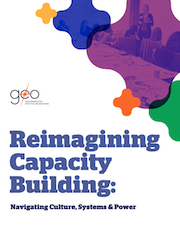Reimaging Capacity Building: Navigating Culture, Systems & Power

Strengthening nonprofit organizations is not just a nice-to-have but an essential part of our work as grantmakers to ensure that nonprofits have the resources they need to address today’s most pressing social concerns. Indeed, the vast majority of staffed foundations — 86 percent — do just that, invest in organizational strengthening in areas such as leadership, fundraising, evaluation, communications and technology.
While capacity building is a critical part of our work, traditional models of capacity building tend not to account for culture, systems and power in their design, too often “rendering them inadequate for communities of color.” The limitations of models that do not consider dynamics of power and issues of equity have never been more apparent than they are now. At the time of this writing, we are navigating a deadly global pandemic and bearing witness to massive protests for racial justice, both of which are bringing renewed attention to the deep and persistent racial inequities that exist in society writ large, including within philanthropic institutions.
In the midst of these seismic societal shifts, our field is taking stock of how we as individuals and institutions are participating in systems that perpetuate inequity, engaging in deep dialogue and reflection on how we can do better, and adopting more equitable and transformative philanthropic practices. And although we must make changes across the breadth of our institutions to become more equitable, capacity building is a particularly powerful case study of how racial inequities show up in our practices and how we can take intentional steps to mitigate those inequities.
